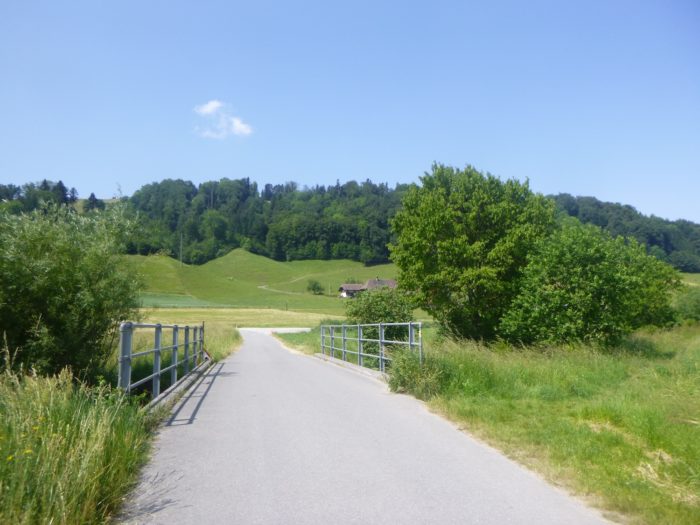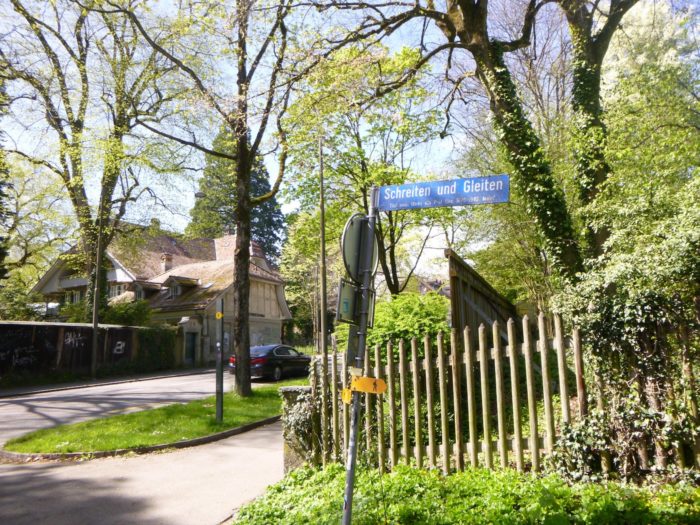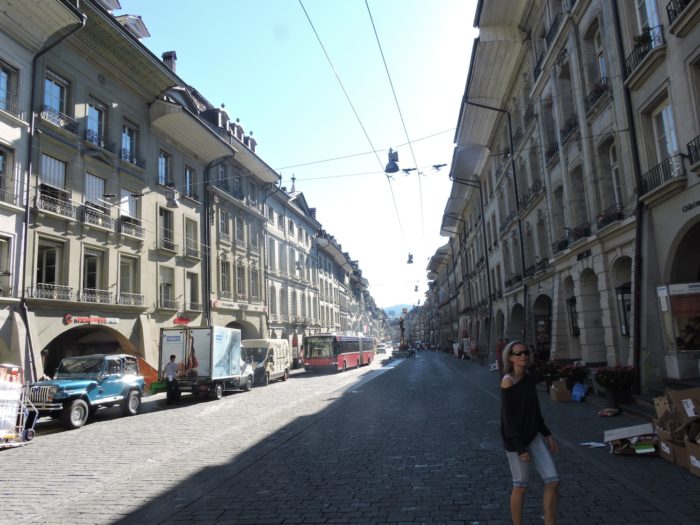To Bern, the capital of Switzerland
DIDIER HEUMANN, ANDREAS PAPASAVVAS

We divided the course into several sections to make it easier to see. For each section, the maps show the course, the slopes found on the course, and the state of the route (paved or dirt roads). The courses were drawn on the « Wikilocs » platform. Today, it is no longer necessary to walk around with detailed maps in your pocket or bag. If you have a mobile phone or tablet, you can easily follow routes live.
For this stage, here is the link:
https://fr.wikiloc.com/itineraires-randonnee/boll-utzigen-a-berne-gare-par-la-via-jacobi-4-167040378
|
Not all pilgrims are necessarily comfortable using GPS or navigating routes on a mobile device, and there are still many areas without an internet connection. For this reason, you can find several books on Amazon dedicated to the major Via Jacobi 4 route, which runs through the heart of Switzerland and over the Brünig Pass. The first guide leads pilgrims through the German-speaking part of Switzerland up to Fribourg, while the second continues through French-speaking Switzerland to Geneva. We have also combined these two books into a compact, lighter, and highly practical version. While the descriptions have been slightly condensed, they remain detailed enough to guide you step by step along the way. Recognizing the importance of traveling light, this latest edition has been designed to provide only the essentials: clear and useful information, stage by stage, kilometer by kilometer. The stages have been carefully adjusted to ensure accessibility and alignment with available lodging options. These books go beyond simple practical advice. They guide you kilometer by kilometer, covering all the crucial aspects for seamless planning, ensuring that no unexpected surprises disrupt your journey. But these books are more than just practical guides. They offer a complete immersion into the enchanting atmosphere of the Camino. Prepare to experience the Camino de Santiago as a once-in-a-lifetime journey. Put on a good pair of walking shoes, and the path awaits you.
|

|
 |
If you only want to consult lodging of the stage, go directly to the bottom of the page.
Many foreigners are surprised to discover that Bern is the capital of Switzerland. They might expect Zurich, the industrial metropolis, or Geneva, the international city, to hold this role. However, Bern was chosen as the « federal city » 170 years ago precisely to avoid an excessive concentration of power. Unlike many other countries, Switzerland long lacked a true capital. This situation arose because, for centuries, the country was a Confederation, an alliance of independent cantons united within a broader framework without real central unity. From the foundation of the Confederation in 1291 until the end of the Old Regime in 1798, the capital of Switzerland was effectively wherever the Federal Diet, the assembly where member cantons discussed common issues, met. This meeting place changed regularly: Zurich, Luzern, Baden, Frauenfeld, and sometimes even Konstanz, a city outside the Confederation, all hosted the Diet at various times. After the invasion of Switzerland by Republican France in 1798, the brief existence of the Helvetic Republic (1798-1803) introduced a desire for centralization, designating Aarau and then Luzern as capitals. These attempts lasted only a few months. To end the troubles of the Helvetic Republic, Napoleon Bonaparte intervened with the Act of Mediation of 1803, restoring the Confederation. The Federal Diet then met in six so-called directorate cantons (Fribourg, Solothurn, Luzern, Bern, Zurich, and Basel) in an annual cycle. In 1848, with the formation of the new federal state, the question of the capital arose again. On November 28, 1848, a majority of members of the new Federal Parliament voted in favor of Bern, preferred over Zurich and Luzern. The parliamentarians sought to avoid concentrating too much power in Zurich, already the country’s economic center, and not to choose Luzern, which opposed the creation of the new federal state. Bern, with its central position, support from French-speaking cantons, and free land offerings, was an equitable solution. There is no legislative text formally stating that Bern is the capital of Switzerland. Two articles simply specify that the Federal Parliament usually sits in Bern and that the city hosts the government, ministries, and the Federal Chancellery. By the presence of the Parliament, the government, and foreign embassies, Bern thus de facto assumes the role of Switzerland’s capital. With 13% of the population, the canton of Bern is the second most populous after Zurich, with one in seven Swiss residents.
Strolling through Bern’s picturesque streets is a true delight for the senses. Albert Einstein and Paul Klee, iconic figures of science and art, enthusiastically walked these same arcades that still attract personalities from around the world as well as locals. The city, with its historic sandstone buildings, majestic bourgeois houses overlooking the arcades, and imposing monuments, is an architectural gem listed as a UNESCO World Heritage site. The Bernese, often perceived as modest, actually nurture a deep pride in their city, its museums, and the famous bear pit, a true emblem of Bern. The quality of life here is exceptional. Walking in the shade of its medieval arcades, you quickly understand why the Bernese are so attached to their unique city. The bear pit is an internationally renowned tourist attraction. Since 2009, the bears have benefited from an additional space: a vast modern park of 6000 square meters accessible via a tunnel, offering the animals a more spacious and natural living environment, and visitors a more captivating experience. The city of Bern not only charms with its historical past; it is also dynamic and lively. The cobblestone streets are full of elegant shops, cozy cafes, and welcoming restaurants. The bustling and colorful open-air markets reflect a rich and vibrant local culture. Festivals and cultural events punctuate the year, attracting crowds celebrating art, music, and gastronomy. Bern’s museums are equally remarkable. The Zentrum Paul Klee, with its impressive collection of works by the famous artist, and the Einstein Museum, which chronicles the life and discoveries of the scientific genius, are must-see stops for any art and culture enthusiast.
Today’s route is an extraordinary walk through the immense forests crowning the hills above Bern. Here you will encounter the country’s most majestic trees: colossal beeches, slender spruces, and imposing Douglas firs that seem to challenge the sky. On the way, however, you will need to cross Ostermundigen, a densely populated suburb of Bern, before returning to fresh air and trees in the park dedicated to Paul Klee. At the edge of the forest, just before crossing the highway, you will see the Paul Klee Center on your left. This unique complex, designed by renowned architect Renzo Piano, creates a perfect symbiosis between nature and culture. The center houses some 4,000 works, including paintings, watercolors, and drawings covering all periods of Paul Klee’s artistic career. Next, the walk continues towards Bern’s famous Bear Park. From this point, the view is simply splendid: the majestic bridge, the picturesque old town, and the steel-blue meander of the Aare below compose an unforgettable tableau. The walk through these varied and enchanting landscapes offers a rich experience in discoveries, combining art, history, and the natural beauty of Bern.

Difficulty level: The terrain of this stage presents a minor challenge, with gentle slopes (+220 meters / -247 meters). However, two sections require more attention: the first climb of Dentenberg, and especially the bumpy descent along the Stampfloch.
State of the Via Jacobi: In this stage, the paths slightly exceed the roads:
- Paved roads: 5.5 km
- Dirt roads : 6.3 km
Sometimes, for reasons of logistics or housing possibilities, these stages mix routes operated on different days, having passed several times on these routes. From then on, the skies, the rain, or the seasons can vary. But, generally this is not the case, and in fact this does not change the description of the course.
It is very difficult to specify with certainty the incline of the slopes, whatever the system you use.
For those seeking « true elevations » and enthusiasts of genuine altimetric challenges, carefully review the information on mileage at the beginning of the guide.

Section 1: On the high hills of Bern

Overview of the route’s challenges: sometimes steep climbs.

|
The journey begins modestly in Boll-Utzigen, where the route from the station, a gateway to Bern from Burgdorf, commences. In this quiet corner of the village, stately homes, an ancestral legacy, stand with discreet nobility, like a procession of yesteryear in the canton of Bern.
|
 |
 |
| The route runs under the railway line and soon crosses the Lindentalbach stream, hidden in the folds of the vegetation, a secret symphony whispered by nature itself. |
 |
 |
A breath of fresh air fills the soul as the road escapes among the pastures, timidly winding behind the village’s last houses, as if to flee the bustle of the modern world.
|
 |
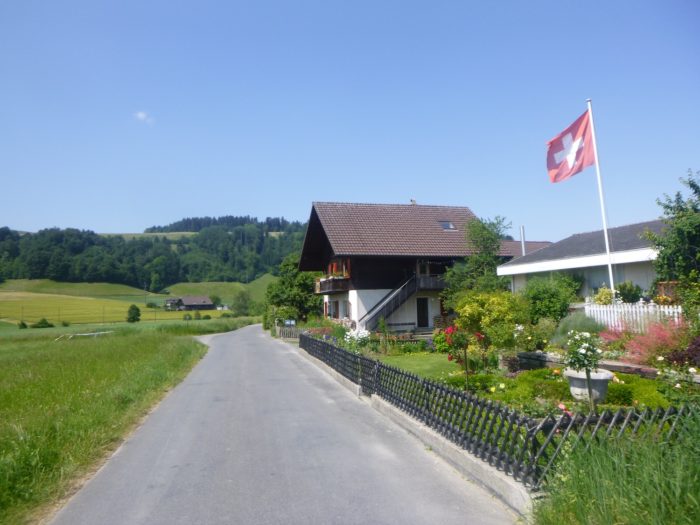 |
| Then, the fleeting embrace of the Lindentalbach renews itself, while further on, the majestic Worble river reveals itself, announcing the approach of the hamlet of Wyler. |
 |
 |
| A waking dream materializes then, Wyler, a perfect sketch of a Bernese farm, where every feature breathes authenticity: the weathered wood, the sloping roof, a tableau of timeless beauty savored with every glance. One never tires of it. |
 |
 |
| A welcome pause offers a respite on the narrow road, moving away from the farm towards the heights, where the landscape reveals itself in all its splendor… |
 |
 |
| …before a narrow, winding trail offers itself to you, revealing challenges that foretell no great news for your legs. |
 |
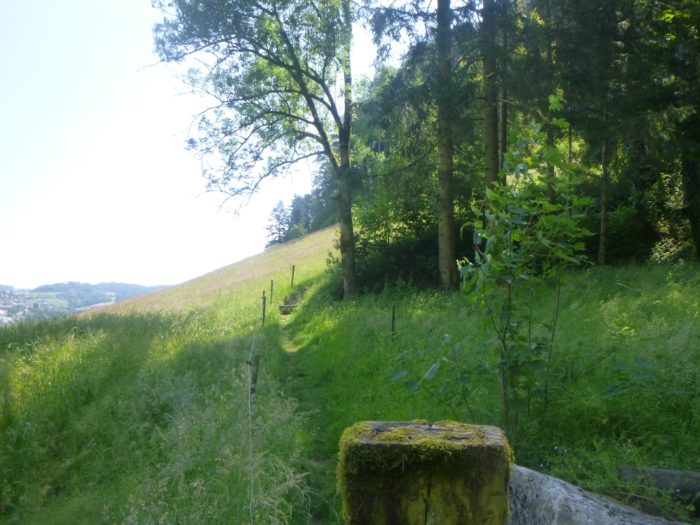 |
| The trail climbs determinedly above the road, embracing the steep slope with daring vigor, alternating between rock-hewn steps and a gravel path that winds confidently. |
 |
 |
| It proves to be much more than just a link, but a dizzying ascent to another horizon, a path stubbornly traced to join another road at the summit. |
 |
 |
| Here unfolds the enchanting palette of Swiss forests, where beeches and spruces stand majestically, their crowns reaching for the sky, while a few discreet maples, solitary oaks, and even shaggy chestnut trees attempt to blend into this living tableau. |
 |
 |
| The road, like a conqueror, finally reaches the heights of Dentenberg… |
 |
 |
| …where a few rare wooden houses reign, silent witnesses of the centuries past, their facades polished by time, their roofs almost defying the heavens. |
 |
 |
Among them, a more recent, imposing residence offers a striking spectacle, reaffirming the architectural audacity typical of this region.
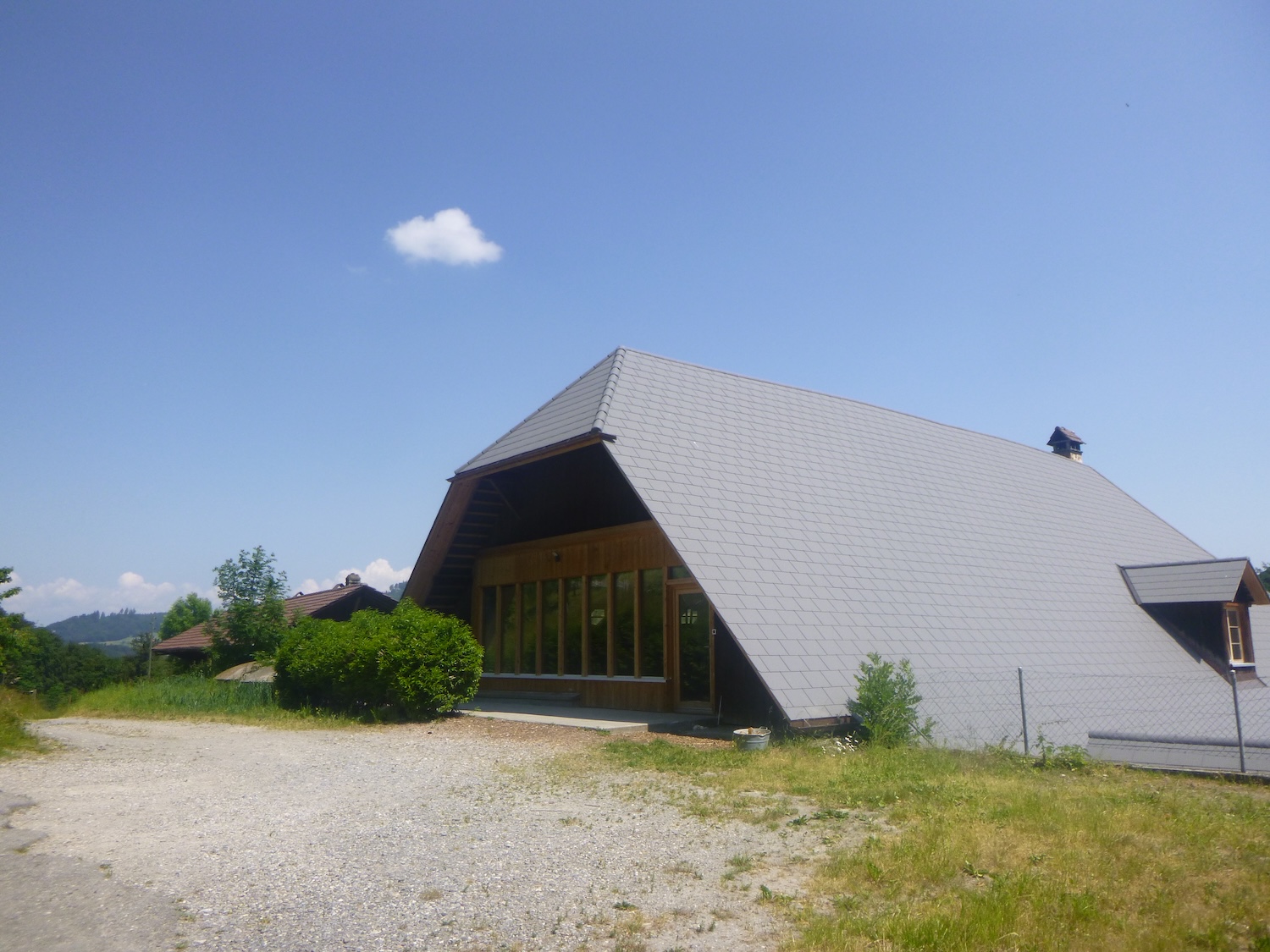
| The Via Jacobi then follows the road that softens its slope, offering a moment of tranquility where exhaustion transforms into respite. |
 |
 |
| Here, a restaurant allows you to take a break. On the horizon, you can see an antenna on the hills, visible from many places when driving near Bern. |
 |
 |
| Shortly after, in the protective shade of a majestic chestnut tree that seems to watch over the surroundings, an additional pleasure awaits, like a precious gift delivered on a golden platter. A steep trail appears among the wild grasses, offering a welcome shortcut to bypass the sharp turn taken by the road. |
 |
 |
| This trail, far from bucolic, soon merges with the main road, which stretches towards Gümligen, offering a peaceful passage, away from urban hustle. |
 |
 |
| You then find yourself walking easily on this tranquil road, where traffic is rare, enveloped by the greenery of meadows dotted here and there with sparse crops, like touches of color on a master’s canvas. |
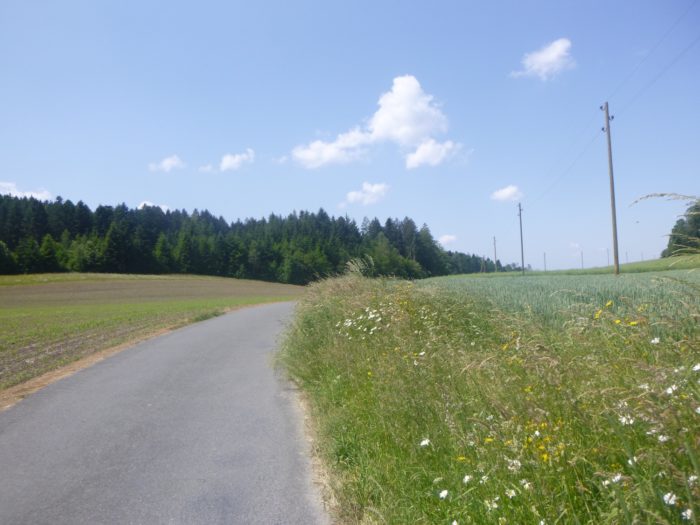 |
 |
| Your route, turning from the woods, reveals a haven of tranquility, a shaded clearing where tall trees extend their protective arms, inviting rest and relaxation. It is here, under this majestic canopy, that a picnic area nestles, like an oasis in the desert of a hectic life. |
 |
 |
| Further on, the Via Jacobi leaves the tarmac to take a more rustic path, a wide, pebbly dirt road winding through the meadows, skirting farms scattered like jewels in a verdant setting. |
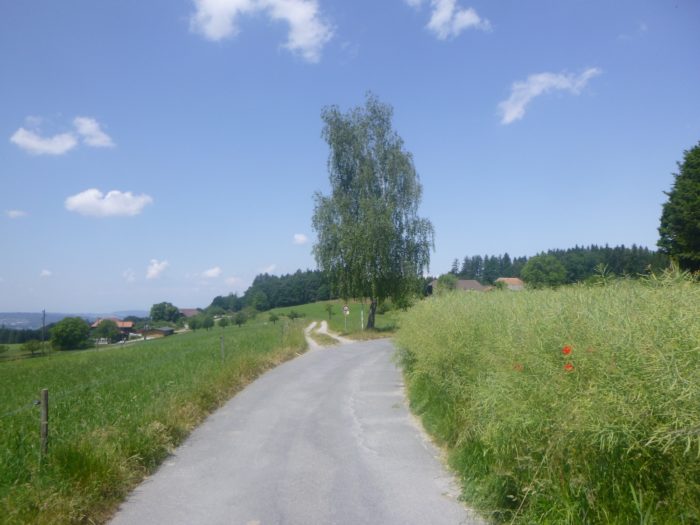 |
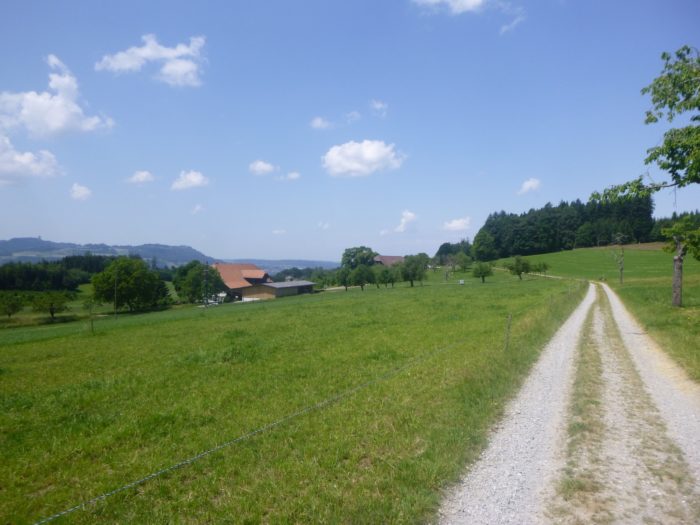 |
This path, worn by the steps of pilgrims, soon leads you to the picturesque hamlet of Amslenberg, where fruit trees and chestnut trees stretch towards the sky like star dancers.

| In this enchanting place, where time seems suspended, a few rare and imposing farms stand, like silent sentinels watching over the slumbering countryside. |
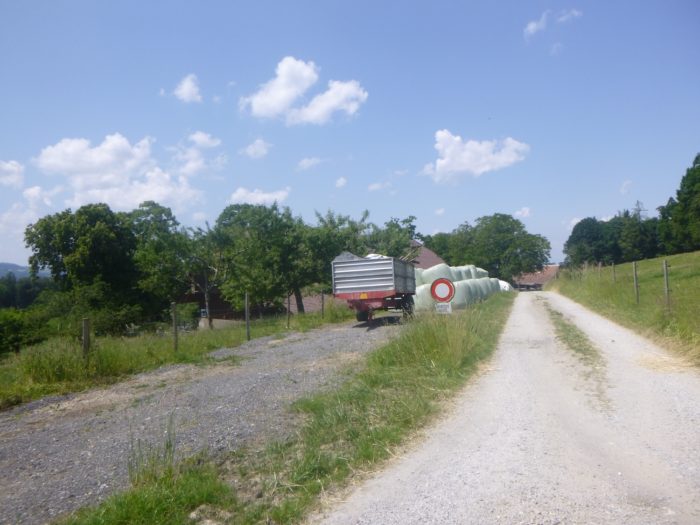 |
 |
| But behind these last bastions of civilization, a rocky path reveals itself, gracefully descending through meadows and fields, today dressed in the undulating gold of wheat, before plunging into the mystery of the dense forest waiting, like an open door to the unknown. |
 |
 |
Section 2: In the great forests of Bern

Overview of the route’s challenges: challenging path along the Stampfloch; then an easy route.


A trail soon plunges into the depths of the forest, unveiling a route that promises an experience as exhilarating as it is captivating. You find yourself facing a dizzying descent, with a steep slope exceeding 30%, plunging you into the heart of this dark and mysterious wood. At times, well-crafted stair ramps stand to offer a secure footing, preventing any unfortunate slips, while at other moments, your steps tread on a hard and compact ground, solid under your assured feet.
|
 |
 |
| On this natural slide of pleasure, you engage with the Stampfloch stream, a fleeting companion whose waters usually flow timidly, except when the whims of the weather decide otherwise. |
 |
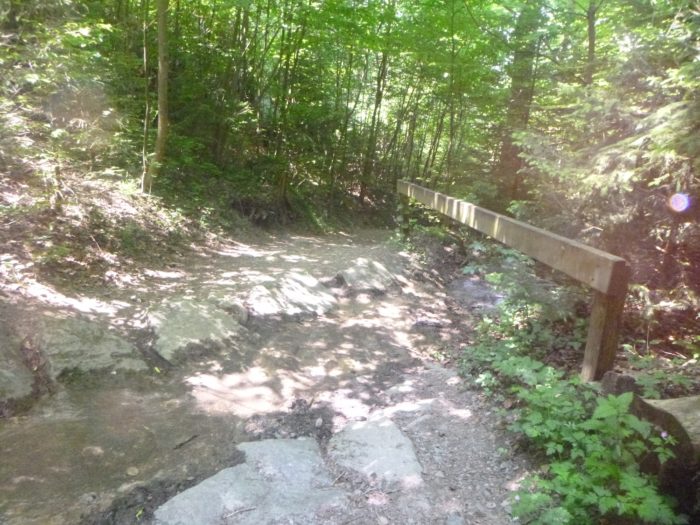 |
| The hide-and-seek game with this mischievous stream stretches over nearly a kilometer, a distance where each step can oscillate between pleasure and pain, depending on the boldness of your adventures. At the bottom of the ravine, timid beginnings of pipelines lie, silent witnesses to the possible presence of water in these places. |
 |
 |
| At the end of this dizzying descent, the path emerges onto a paved parking lot, a junction point between the wildness of nature and the civilized world. |
 |
 |
| The parking lot, a frequent gathering place on shooting days, houses a shooting range belonging to a local society. This activity, emblematic of Swiss and American traditions, has become part of the cultural landscape, although in Switzerland, its appeal is gradually fading, except for military citizens adhering to the annual shooting practice requirement. |
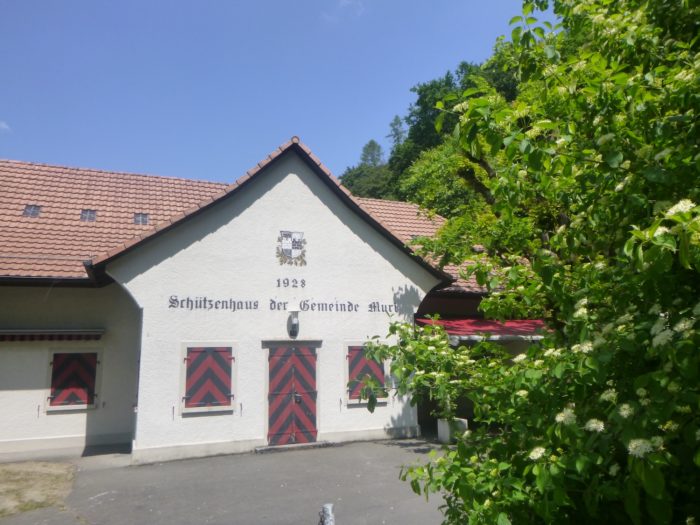 |
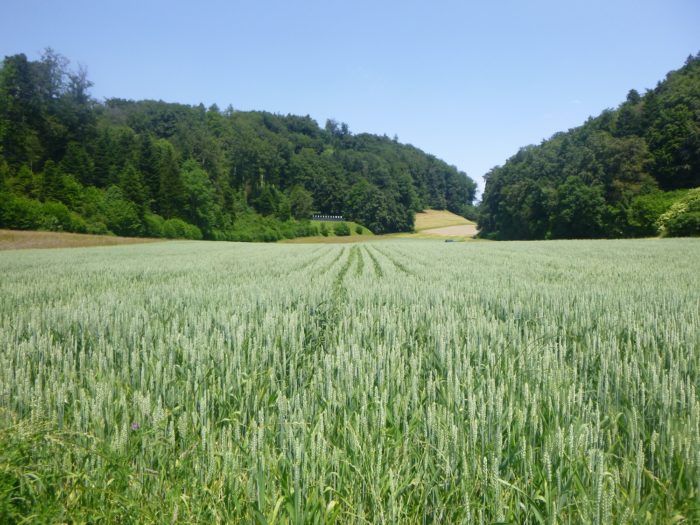 |
You are now only fifteen minutes away from Gümligen, a proximity that testifies to the accessibility of this natural haven.

| The dirt path, as if drawn by a magnet, quickly reconnects with the forest proudly bearing the name Grossholz, a designation that alone evokes its majestic extent. The surrounding villages, Grümligen, Meichenbühl, Ostermundigen, all nestle under the protective cover of this immense forest that magnificently extends over the hill, towering over the city of Bern with its grandeur. |
 |
 |
| The forest that welcomes you is truly divine. The imposing Douglas firs and majestic spruces defy the skies, towering several cubits above the other giants, which already include spruces, pines, oaks, maples, chestnuts, and beeches. Faced with their imposing stature, your own smallness can only humble you. |
 |
 |
| Sometimes bathed in darkness, sometimes illuminated by the gentle rays of the sun, the path of pleasure winds through this venerable wood, occasionally revealing remnants of the old VITA trails, silent witnesses of a bygone era. |
 |
 |
| Lower down, the trees seem to gradually become less imposing, announcing a return to civilization as the path skirts the locality of Rütibüel, located an hour and ten minutes from the Bärenpark (Bear Pit). . |
 |
 |
| Yet, true to its nature, the path persists in the woods, plunging into wide shaded avenues, distancing any noise of urban hustle. |
 |
 |
| The trees here seem to regain height, still as straight as Mikado sticks, testifying to the majesty and serenity of this wooded sanctuary. |
 |
 |
| Further on, the path briefly detours near the Ostermundigen swimming pool, offering a clear view of the suburban towers of Berne stretching as far as the eye can see. |
 |
 |
| At the level of the pool, the path slopes up into the undergrowth, as if the planners of Schweizmobil were striving to avoid the proximity of the city as much as possible. And their intention is easily understandable. |
 |
 |
| The path then climbs slightly on the Hubel hill, brushing against buildings that seem to stand both above and below its course. Along its way stands a beautifully restored farm, a living testament to the marriage between tradition and modernity. |
 |
 |
At Hubel, near a large lime tree, the route begins a descent towards the greater suburbs of Berne, the town of Ostermundigen, home to 18,000 inhabitants. However, a significant trap lies here. If you pay attention to the signpost, you will notice that the directions for Ostermundigen or for the Via Jacobi 4 are slightly offset. But what walker, unalerted, pays such attention to details?

| Yet, it is crucial to do so, for two yellow diamonds adorn the landscape: one pointing towards Hubelstrasse on a pole to the right of the road, while the other seems to invite you to continue straight ahead. But this impression is misleading, as a third sign indicates that the route leaves the road. The direction is also mentioned on a blue sign: Fussweg nach Dennigkofen. |
 |
 |
Thus, if you miss this bifurcation, you will find yourself forced to bypass the center of Ostermundigen, risking getting lost in a maze of often poorly indicated streets. Without intending to offend the responsible parties of Schweizmobil, one could argue that they could have made this decision easier to understand. After all, not all pilgrims are familiar with the streets of Bern?
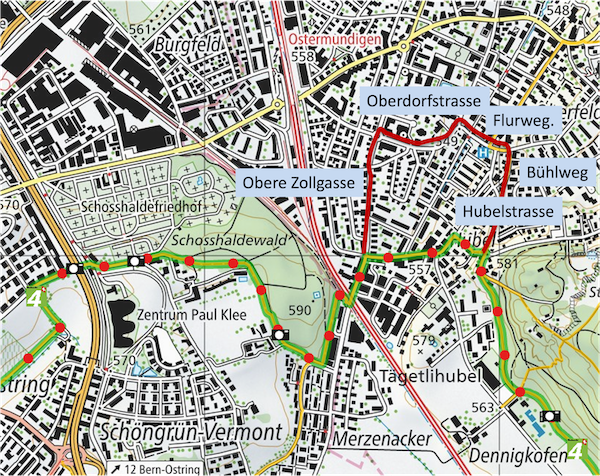
|
Here, on the Via Jacobi, the experience becomes a pure delight, as a concrete staircase presents itself to you, descending over thirty meters like a spiral staircase in a multi-story house.
|
 |
 |
| At the end of this dizzying descent, the Via Jacobi takes a foothold in a few quiet streets of Obermundingen, gently insinuating itself into the less dense urban fabric of this locality. |
 |
 |
| From there, it makes its way to Obere Zollgasse, a road emerging from the city towards the industrial area, passing under significant railway lines. |
 |
 |
| This industrial and service area spreads out over a vast expanse, testifying to the incessant activity animating these places. |
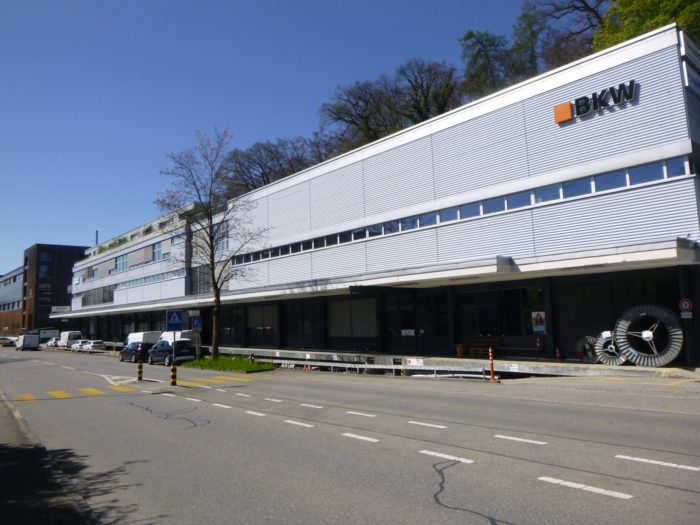 |
 |
| Shortly after, the Via Jacobi skillfully escapes urbanity, finding the fresh breath of nature. No pilgrim will complain. A path once again escapes into the woods, plunging behind the forestry company towards the Paul Klee Park. |
 |
 |
| This wide path slopes up with a quite reasonable slope through bushes of maples and hornbeam shoots… |
 |
 |
| …before the majestic tall trees, imposing oaks and slender beeches, reappear quickly. |
 |
 |
| Welcoming benches invite rest, picnic areas nestle in this wood, delighting local hikers, especially on sunny Sundays. |
 |
 |
| As you walk through the park’s paths, you will notice unique street names. Indeed, the eighteen paths crisscrossing this place bear the names of Paul Klee’s paintings. Bern was for Klee a land of rediscovered inspiration and a haven of peace. Born nearby, he filled entire notebooks with views of Bern during his adolescence. Moving to Germany in 1906, he fled the rise of Nazism in 1933 to return to Bern, where he drew his last breath in 1940, leaving behind more than 1250 recorded works. |
 |
 |
| The alleys here, strikingly beautiful, invite a serene walk, on flat terrain conducive to meditation. |
 |
 |
| At the edge of the forest, the numerous buildings of the Christophorus school, heir to Steiner’s anthroposophic pedagogy, unfold, a movement of thought advocating proximity to nature and perceiving the world as animated by spiritual forces. Although some voices consider them sectarian, these schools thrive in the canton of Bern. |
 |
 |
Section 3: From the Paul Klee Center to the Bear Pit

General overview of the route’s challenges: an easy route.

| The Via Jacobi enjoys a bit more of the company of the avenues, whose names evoke the canvases of the famous painter, before continuing its way near a beautiful cemetery nestled under the trees’ canopys. |
 |
 |
| Then, gradually, it moves away from the woods, skirting the cemetery entrance… |
 |
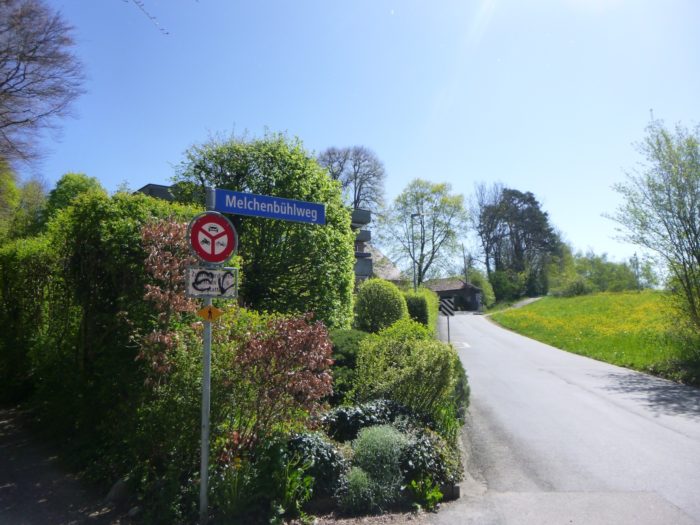 |
| … before heading towards the Paul Klee Center, ideally located near Bern’s major bypass highway. At this point, you are just a thirty-minute walk from the Bear Pit, another treasure of the region. |
 |
 |
| Crossing the highway with determination, the Via Jacobi heads towards the city’s outskirts, where imposing residential blocks rise. |
 |
 |
On the other side, the three rolling hills of the Paul Klee Center blend harmoniously into the landscape, a creation of Italian architect Renzo Piano, who built this center in 2005. This place houses the world’s largest collection of the painter’s works, providing a cultural context dedicated to his art.

| Previously, the Via Jacobi would reach the Bear Pit more quickly by crossing the residential buildings on the right side of the road. Today, the route has been wisely adjusted, offering pilgrims a peaceful crossing through the countryside. Although it lengthens the journey, it is always preferable to walk in the heart of nature rather than amid urban constructions. |
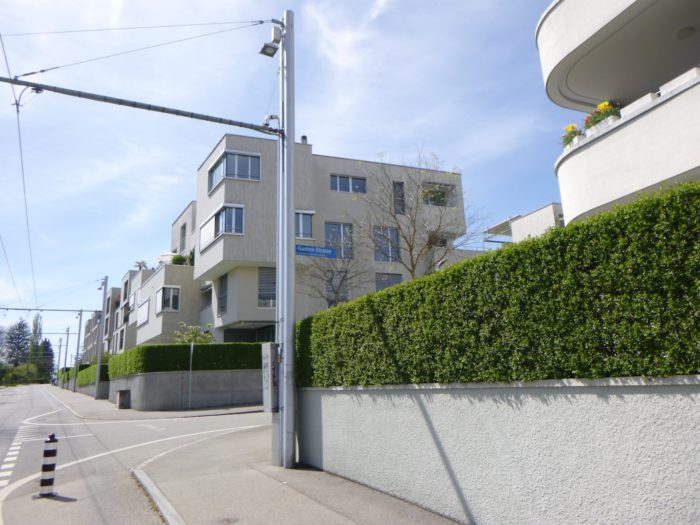 |
 |
| A beautiful paved path plunges into nature, passing near the Paul Klee Center, offering walkers an irresistible invitation to discover the splendors of this preserved landscape. |
 |
 |
|
At the bottom of the descent, the path cleverly veers to the right, while each path remains true to the artistic heritage of the painter, bearing the evocative name of his paintings. Each step feels like a new stage in an open-air gallery, where nature itself becomes a work of art.
|
 |
 |
|
A long straight line then unfolds, cutting through fields, a perspective surprising by the unexpected presence of vineyards, a surprising nod in a canton rarely associated with viticulture.
|
 |
 |
At the horizon of this infinite line, the path crosses a bustling road, where the frantic pace of modern life contrasts with the rural tranquility.
|
 |
 |
| On the other side of this urban artery, the path continues its journey, faithful to its artistic homage, slipping between the trees in a graceful ballet inspired by the master’s canvases. |
 |
 |
| It winds through a shaded grove, offering hikers a welcome break at a picnic area… |
 |
 |
| … before gracefully skirting a rather discreet playground. |
 |
 |
| Skillfully circumventing the playground, the path then reveals the delicate Egelsee lake, hidden among the verdant foliage, like a treasure preserved from prying eyes. |
 |
 |
| The path leads into the park on a pleasant roundabout under the trees. |
 |
 |
| This is a true haven of peace, where the murmur of the leaves and the gentle lapping of the water blend into a soothing symphony. Continuing its journey through the park, the path proves to be a true contemplative walk under the protective shade of ancient trees. Each step feels like an invitation to meditation, an opportunity to get lost in the meanders of nature. |
 |
 |
| At the end of the lake, the route turns onto a final path evoked by the painter’s canvases to find itself on a long avenue in Bern’s outskirts, where the houses appear more frequently. |
 |
 |
| Further on, as the route moves away from the main roads to venture onto more intimate paths, the atmosphere becomes more peaceful, as if time itself slows down to better savor each moment of this walk. |
 |
 |
| The majestic residences lining the road seem to silently watch over the travelers’ path, like guardians of the history of this city steeped in traditions and legends. |
 |
 |
| Then, as if guided by an invisible hand, hikers take a steep paved path, where each stone seems to tell the secrets of the past, each blade of grass testifies to the vitality of this nature that withstands the passage of time. |
 |
 |
| A small bridge, symbolizing the symbiosis between man and his environment, gracefully spans the path, offering awestruck eyes a perspective on the hidden treasures of this preserved region. Some wealthy Bernese are undoubtedly very fortunate to live on the hill at the end of the cul-de-sacs. |
 |
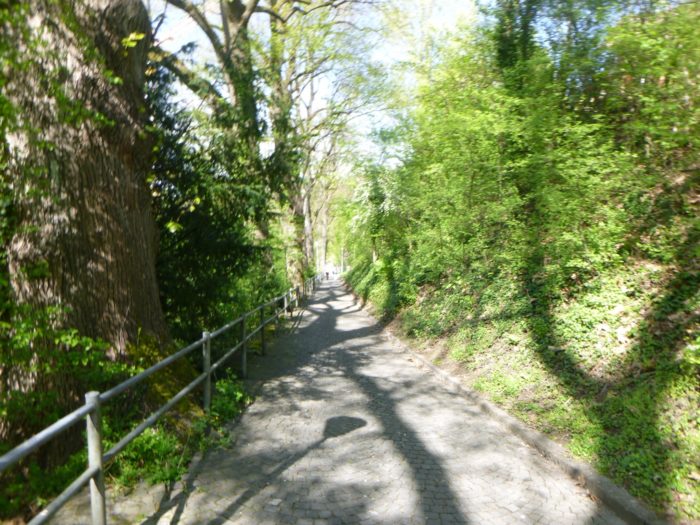 |
| And suddenly, like a painting coming to life, the city of Bern unfolds in all its grandeur, its majestic monuments proudly standing against the horizon, witnesses of a glorious past and a vibrant present. Bern is undoubtedly one of the most beautiful cities in Switzerland, if not the most beautiful, rivaling Luzern. |
 |
 |
| As the path approaches the Bear Pit, the hum of cars gives way to the song of birds and the rustling of leaves, heralding the entrance into a natural sanctuary where tranquility reigns supreme. The tour buses are lined up like grand monuments to Bern’s memory. |
 |
 |
The Bear Pit, with its fascinating history and enchanting landscapes, embodies the very soul of this city, a perfect harmony between nature and civilization. The bears have moved from here to much more suitable places.

| On the banks of the Aare, the fourth pit of its name was originally inaugurated in 1857, although the presence of a bear reserve in the city is confirmed as early as 1441. It recalls the legend that Duke Berthold V of Zähringen, the founder of the city, captured one of these animals towards the end of the 12th century. Enlarged in 1925 with the addition of a pit reserved for bear cubs, and later renovated, it has not housed bears since 2009, following the creation of the adjacent Bear Park. |
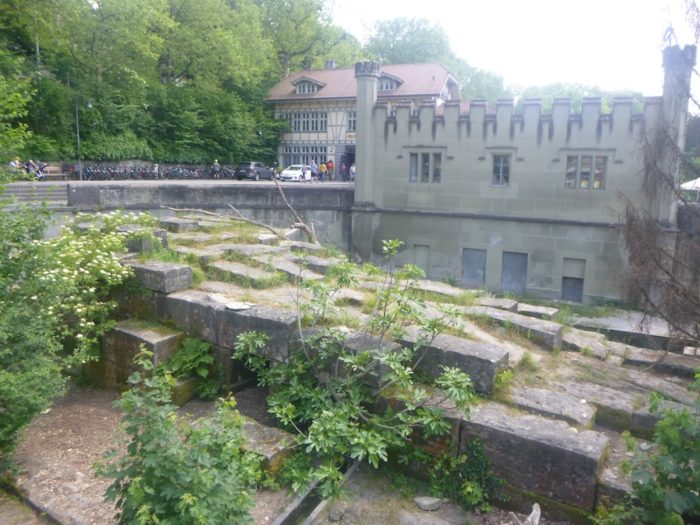 |
 |
| Here are two old images of the bears in the pit. |
 |
 |
| The Bernese bears feel at home in the Bear Park, right in the heart of the city. They enjoy an exceptional setting on the slopes bordering the Aare, overlooking the old town of Bern, a UNESCO World Heritage site. The terrain of about 5000 square meters extends from the old bear pit to the banks of the Aare and can be explored without difficulty. Since October 2009, this new park has been home to two brown bears, a male named Finn and a female named Björk. In 2009, Björk gave birth to two cubs, Ursina and Berna. Ursina still resides in the park with her parents, while Berna had to leave the park in 2013 for the Dobric Zoo in Bulgaria, as she became too aggressive towards her mother. Here, everything depends on the bears’ willingness to grace you with their presence. They explore their enclosures, graze on grass, sniff each other intensely, or play together. Most often, on sunny days, they can be found near the large paddling pool by the river, but if you are luckier, you may see them napping closer to you. To spot them, the easiest way is to find the spot along the path where clusters of onlookers are gathered, eagerly awaiting a glimpse of these massive, furry creatures. |
 |
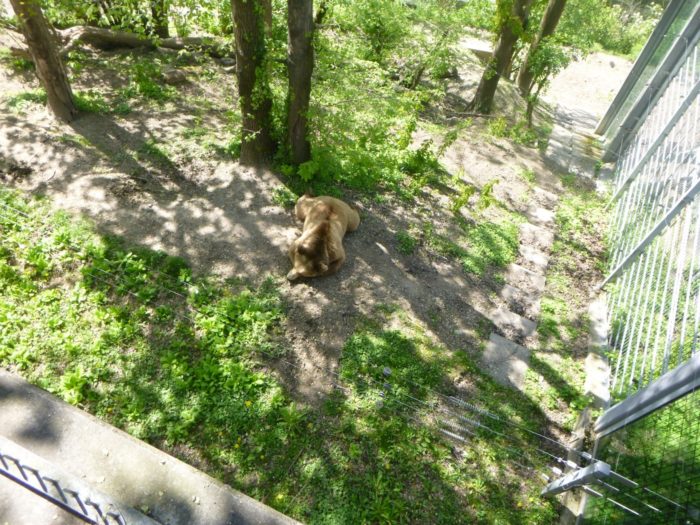 |
Section 4: A few steps in Bern
| From the tranquil Bear Park, several routes lead directly to the old town of Bern. You can choose to cross the majestic Nydegg Bridge, which spans the Aare River, offering a stunning view of the city, or explore the mysteries hidden under its arches by taking the iron staircase or the elevator, accessible even to people with reduced mobility. A beautiful walk along the water awaits you, almost at the edge of the Aare, a charming and peaceful experience. |
 |
 |
| If you prefer to follow the river, you will need to climb up to the old town level by taking the cobbled streets and beautiful squares that punctuate the route. |
 |
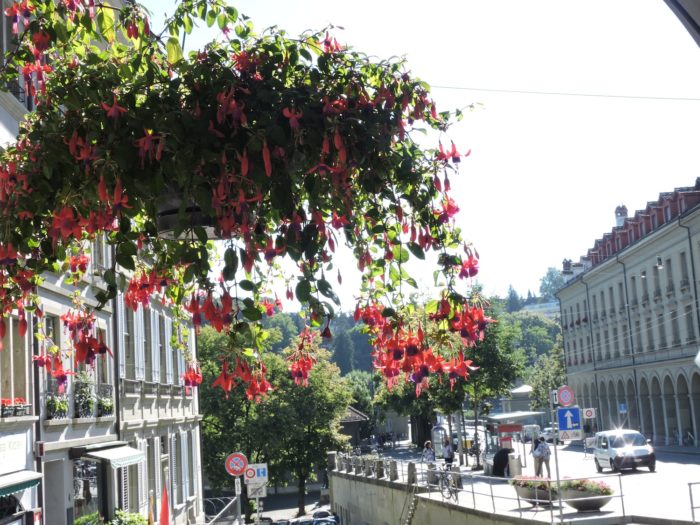 |
| Once in the bustling streets of the old town, you cannot miss the dynamic presence of Asian tourists, who always seem to be in front of jewelry stores and the famous Victorinox knife shops. In Bern, as in Luzern, their presence is ubiquitous, creating a cosmopolitan and lively atmosphere. When strolling in Luzern or Bern, you get the feeling that only Asian tourists are wandering the streets. Naturally, it is more difficult to distinguish a European or American tourist from a native Swiss. |
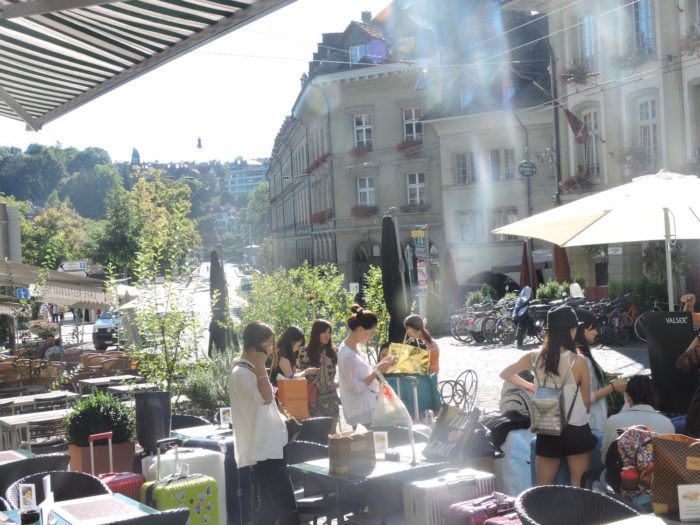 |
 |
| Not far from the Nydegg Bridge stands the majestic Rathaus, the town hall, the political heart of the canton of Bern for over six centuries. It is here that the cantonal Parliament and government meet, in a building that elegantly combines the late Gothic style of its initial construction, the sobriety of the neo-Gothic renovation in the 19th century, and the resolutely modern character of the latest renovations carried out between 1940 and 1942. |
 |
 |
 |
 |
The majestic Bern Cathedral, also known as the Münster or Collegiate Church of St Vincent, is a dazzling example of late Gothic style, testifying to a rich history and remarkable architecture. Over six centuries old, it stands as a sentinel of faith and is proudly claimed as the largest church in Switzerland. The foundations of this architectural marvel were laid in 1421, and its construction spanned over 150 years, demonstrating the ingenuity and perseverance of the builders of the time. However, its history does not end with its initial construction. On the contrary, it is steeped in the tumult of the Reformation in Bern, where Zwingli’s supporters played a central role. In 1528, during a historic 20-day meeting attended by 450 delegates, the radical decision to reform Bern was made. This reform had significant repercussions: the Catholic mass was abolished, churches were stripped of their sacred character to become simple warehouses, and monasteries were closed. Even the magnificent swallow’s nest organs, dubbed by Zwingli as the « bagpipes of the devil » due to their supposed distraction of the faithful during sermons, were removed during the Reformation’s reorganization. In the 16th century, the third phase of the Collegiate Church’s construction ended, but the tower that overlooked the city only reached 50 meters in height. It was not until much later, in 1893, that the impressive Gothic tower in its entirety was completed, giving the church its imposing current appearance. Built mainly of regional sandstone, the Bern Cathedral remains an architectural jewel, a living testimony to the city’s tumultuous history and unwavering faith.

| Strolling through the city center of Bern is a delightful experience, where you can leisurely wander along the shops and cafes, sheltered under the elegant arcades that punctuate the main axis of the old town up to the station. Even in rainy weather, the pleasure remains, protected from the elements, in this maze of preserved arcades that retain all their old-world charm. |
 |
 |
| Although the main arteries of the center are used by trams and buses, they remain animated by the assured steps of pedestrians, who sometimes prefer the open streets to the arcades. |
 |
 |
| The fountains, adorned with often warrior statues, line the route, offering floral compositions increasingly enchanting. |
 |
 |
 |
 |
| But it is the imposing silhouette of the Zytglogge, the famous Clock Tower, that invariably attracts the eye in the lower town. Once a city gate, it fascinates visitors from around the world with its history and remarkable architecture. Inside its ancient walls, time seems suspended, with its medieval mechanics and massive wooden beams, witnesses of a glorious past. After surviving a devastating fire in 1405, the tower was rebuilt to fulfill a new function: that of a belfry, announcing the hour to the Bernese every hour. It thus became the point of reference for the whole of Switzerland, calibrating the clocks of the cantonal routes and becoming the « Swiss Greenwich. » The Zytglogge is also famous for its astrolabe and its movement dating from 1530. At each change of hour, an enchanting spectacle unfolds: bears dance, a jester rings the bell too early, chimes resonate, and Chronos, the god of time, turns his hourglass. It is a magical symphony that captivates visitors every hour. |
 |
 |
From street to arcade, from statue to statue, the walk will eventually lead you to the station, reminding that even in the heart of modernity, the tradition and timeless charm of Bern remain ever-present. Tomorrow, you will visit the other part of the city, starting from Bern, towards the Federal Palace and the river.

Accommodation on Via Jacobi
- Jugendherberge, Weihergasse 4, Bern; 031 326 11 11; Youth hostel, dinner, breakfast
- Hotel Pension Marthahaus, Wyttenbachstrasse 22a, Bern; 031 332 41 35; Hotel, dinner, breakfast
- Bern Bacckpapers Hotel Glocke, Rathausgasse 75, Bern; 031 311 37 71; Hotel, dinner, breakfast
- Hotel Jardin, Militärstasse 8, Bern; 031 333 01 17; Hotel, dinner, breakfast
Finding accommodation at the end of this stage is not particularly difficult. Along the route, there are a few rare restaurants. You will end the stage in a town with all necessary shops. Accommodations are plentiful in a larger town. For other lodging options that are not guesthouses or small hotels, check the internet or contact the Bern Tourist Office. It is advisable to make a reservation for peace of mind.
Feel free to add comments. This is often how you move up the Google hierarchy, and how more pilgrims will have access to the site.
|
 |
Next stage : Stage 15: From Bern to Rüeggisberg |
|
 |
Back to menu |
















